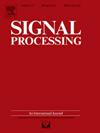Deep fully-connected tensor network decomposition for multi-dimensional signal recovery
IF 3.4
2区 工程技术
Q2 ENGINEERING, ELECTRICAL & ELECTRONIC
引用次数: 0
Abstract
Fully-connected tensor network (FCTN) decomposition has garnered significant interest for processing multi-dimensional signals due to its ability to capture the all-mode correlations of a tensor. However, its representation ability is still limited, particularly for representing fine details and complex textures. To break this limitation, we propose deep fully-connected tensor network (D-FCTN) decomposition with a powerful representation ability beyond FCTN decomposition. Specifically, D-FCTN decomposition consists of two pivotal building blocks: the intrinsic low-rank representation block and the deep transform block. In the intrinsic low-rank representation block, we use FCTN decomposition to capture the all-mode correlations in the low-dimensional latent space, which implicitly regularizes the recovered signal. In the deep transform block, the latent space is transformed to the original signal space by leveraging a deep neural network due to its mighty expressive capability. The intrinsic low-rank representation boosted by the deep transform is expected to deliver a more powerful representation ability for recovering multi-dimensional signals beyond FCTN decomposition. To examine the representation ability of D-FCTN decomposition, we suggest an unsupervised D-FCTN decomposition-based multi-dimensional signal recovery model. Experiments on multi-dimensional signals demonstrate the more powerful representation ability of D-FCTN decomposition especially for recovering fine details and complex textures, compared with the state-of-the-art methods.
用于多维信号恢复的深度全连通张量网络分解
由于能够捕获张量的全模式相关性,全连接张量网络(FCTN)分解在处理多维信号方面获得了极大的兴趣。然而,它的表现能力仍然有限,特别是对于精细细节和复杂纹理的表现。为了打破这一限制,我们提出了深度全连接张量网络(D-FCTN)分解,它具有超越FCTN分解的强大表示能力。具体来说,D-FCTN分解由两个关键的构建块组成:固有的低秩表示块和深度变换块。在固有的低秩表示块中,我们使用FCTN分解来捕获低维潜在空间中的全模式相关性,从而隐式正则化恢复的信号。在深度变换块中,利用深度神经网络强大的表达能力,将潜在空间变换为原始信号空间。深度变换增强的内禀低秩表示有望提供比FCTN分解更强大的多维信号恢复表示能力。为了检验D-FCTN分解的表示能力,我们提出了一种基于无监督D-FCTN分解的多维信号恢复模型。对多维信号的实验表明,与现有方法相比,D-FCTN分解具有更强的表征能力,特别是对精细细节和复杂纹理的恢复。
本文章由计算机程序翻译,如有差异,请以英文原文为准。
求助全文
约1分钟内获得全文
求助全文
来源期刊

Signal Processing
工程技术-工程:电子与电气
CiteScore
9.20
自引率
9.10%
发文量
309
审稿时长
41 days
期刊介绍:
Signal Processing incorporates all aspects of the theory and practice of signal processing. It features original research work, tutorial and review articles, and accounts of practical developments. It is intended for a rapid dissemination of knowledge and experience to engineers and scientists working in the research, development or practical application of signal processing.
Subject areas covered by the journal include: Signal Theory; Stochastic Processes; Detection and Estimation; Spectral Analysis; Filtering; Signal Processing Systems; Software Developments; Image Processing; Pattern Recognition; Optical Signal Processing; Digital Signal Processing; Multi-dimensional Signal Processing; Communication Signal Processing; Biomedical Signal Processing; Geophysical and Astrophysical Signal Processing; Earth Resources Signal Processing; Acoustic and Vibration Signal Processing; Data Processing; Remote Sensing; Signal Processing Technology; Radar Signal Processing; Sonar Signal Processing; Industrial Applications; New Applications.
 求助内容:
求助内容: 应助结果提醒方式:
应助结果提醒方式:


